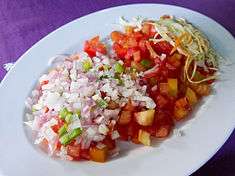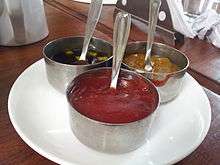Kachumbari
 Kachumbari | |
| Course | Salad |
|---|---|
| Region or state | African Great Lakes |
| Main ingredients | Tomato, onion, |
| Ingredients generally used | Chilli and salt |
| Variations | Lime/lemon juice, coriander, parsley, cucumber, avocado, gin, vodka |
| Similar dishes | Pico de gallo, salsa fresca |
Kachumbari is a fresh tomato and onion salad dish that is popular in the cuisines of the African Great Lakes region. It is an uncooked salad dish consisting of chopped tomatoes, onions, and chili peppers (and salt to taste). Variations of Kachumbari can be found in Kenya, Tanzania, Rwanda, Uganda, Burundi and in Southern African countries of Malawi and Congo.
The Swahili word Kachumbari originated from the Indian word "cachumber".
Uses
Kachumbari is used like a salad side dish for a main meal.
In Kenya, it is used as a condiment served with pilau (pilaf),[1] mukimo,[2] or a meal of nyama choma (roasted meat) and ugali. In Tanzania, it is eaten with rice pilau or biryani. In Malawi, it is usually eaten on its own like any other salad dish while in Uganda it is normally eaten with nyama choma.
Variations
Other ingredients like lime or lemon juice, fresh cilantro (coriander or dhania), parsley, avocado or cucumber, and in some cases gin or vodka, can also be added. Some recipe variations also call for habanero chili peppers or Scotch bonnet peppers, with a touch of ground cayenne pepper.[3]
Kachumbari is popular throughout the African Great Lakes region and can be eaten with African pilaf rice and African biryani.
See also
References
- ↑ Bala, Nithu. "Kachumbari - East African Salad". nithubala.com. Retrieved 24 July 2012.
- ↑ "Recipe: Mukimo". African Cook.
- ↑ Bala, Nithu. "Kachumbari - East African Salad". nithubala.com. Retrieved 24 July 2012.
